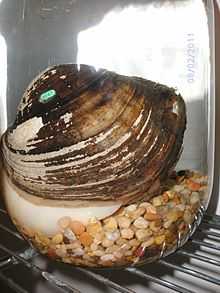Lampsilis cardium
| Lampsilis cardium | |
|---|---|
 | |
| Conservation status | |
| Scientific classification | |
| Kingdom: | Animalia |
| Phylum: | Mollusca |
| Class: | Bivalvia |
| Order: | Unionoida |
| Family: | Unionidae |
| Genus: | Lampsilis |
| Species: | L. cardium |
| Binomial name | |
| Lampsilis cardium Rafinesque, 1820 | |
Lampsilis cardium is a species of freshwater mussel in the family Unionidae, the river mussels. It is known commonly as the plain pocketbook.[1] It is widespread in eastern North America, where it is native to the Mississippi River and Great Lakes drainage systems.
Reproduction
All Unionidae are known to use the gills, fins, or skin of a host fish for nutrients during the larval glochidia stage. Lampsilis cardium accomplishes this by having the inner sides of its mantle flaps marked with longitudinal stripes, resembling a small fish of the genus Notropis. When these are attacked and ruptured by a striking predator fish, the mussel larva is released into the gills of the host fish where it feeds and develops.[1]
References
- ↑ 1.0 1.1 Plain pocketbook, Lampsilis cardium. Unio Gallery. Missouri State University.
External links
- Bogan, A. E. 1996. Lampsilis cardium. In: IUCN 2013. IUCN Red List of Threatened Species. Version 2013.2. Downloaded on 26 December 2013.
